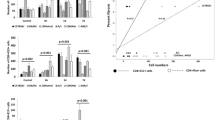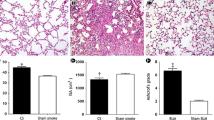Abstract
The CYP1A1 hyperinducibility phenotype occurring in some 10% of the human population corresponds to a higher risk of developing lung cancer. This study was undertaken to assess whether the inducibility factor, generally evaluated on mitogen- activated lymphocytes after PAH induction, represents correctly the lung situation. Optimal experimental conditions were determined for evaluating, on both lymphocytes and lung tissue explants, the inducibility factor, defined as the ratio of EROD activity (CYP1A1-specific) to cytochrome c reductase activity (unaffected by PAH induction). Paired results for lymphocytes and lung tissue samples from 10 lung cancer patients were compared. A good correlation was observed between lymphocyte and lung tissue inducibilities (R = 0.809; p = 0.005). In conclusion, mitogen- activated lymphocyte inducibility is indicative of lung tissue inducibility and constitutes a good marker for evaluating individual PAH inducibilities.
Similar content being viewed by others
References
Quan T, Reiners JJ Jr, Bell AO, Hong N, States JC. Cytotoxicity and genotoxicity of (±)-benzo[a]pyrene-trans-7,8-dihydrodiol in CYP1A1-expressing human fibroblasts quantitatively correlate with CYP1A1 expression level. Carcinogenesis 1994; 15: 1827–1832.
Dahl AR, Lewis JL. Respiratory tract uptake of inhalants and metabolism of xenobiotics. [Review]. Annual Review of Pharmacology & Toxicology 1993; 33: 383–407.
Anttila S, Hietanen E, Vainio H, Camus AM, Gelboin HV, Park SS, Heikkila L, Karjalainen A, Bartsch H. Smoking and peripheral type of cancer are related to high levels of pulmonary cytochrome P450IA in lung cancer patients. International Journal of Cancer 1991; 47: 681–685.
Kouri RE, McKinney CE, Slomiany DJ, Snodgrass DR, Wray NP, McLemore TL. Positive correlation between high aryl hydrocarbon hydroxylase activity and primary lung cancer as analyzed in cryopreserved lymphocytes. Cancer Research 1982; 42: 5030–5037.
Mc Lemore TL, Adelberg S, Liu MC, Mc Mahon NA, Yu SJ, Hubbard WC, Czerwinski M, Wood TG, Storeng R, Lubet RA, Eggsleston JC, Boyd MR, Hines RN. Expression of CYP1A1 Gene in patients with lung cancer: evidence for cigarette smoke-induced gene expression in normal lung tissue and for altered gene regulation in primary pulmonary carcinomas. J Natl Canc Inst 1990; 82: 1333–1339.
Kouri RE, McKinney CE, Levin AS, Edwards BK, Vesell ES, Nebert DW, Mc Lemore TL. Variation in aryl hydrocarbon hydroxylase activities in mitogenactivated human and non human primate lymphocytes. Toxicologic Pathology 1984; 12: 44–48.
Paigen BE, Gurtoo HL, Minowada JU, Houten LO, Vincent RO, Paigen KE, Parker NA, Ward EL, Hayner NA. Questionable relation of aryl hydrocarbon hydroxylase to lung-cancer risk. New England Journal of Medicine 1977; 297: 346–350.
Mc Lemore TL, Martin RR, Busbeen DL, Richie RC, Springer RR, Toppell KL, Cantrell ET. Aryl hydrocarbon hydroxylase activity in pulmonary macrophages and lymphocytes from lung cancer and noncancer patients. Cancer Research 1977; 37: 1175–1181.
Landi PJ, Bertazzi PA, Shields PG, Clark G, Lucier GW, Garte SJ, Cosma G, Caporaso NE. Association between CYP1A1 genotype, mRNA expression and enzymatic activity in humans. Pharmacogenetics 1994; 4: 242–246.
Catteau A, Douriez E, Beaune P, Poisson N, Bonaiti-Pelle C, Laurent P. Genetic polymorphism of induction of CYP1A1 (EROD) activity. Pharmacogenetics 1995; 5: 110–119.
Kellermann G, Shaw CR, Luyten-Kellerman M. Aryl hydrocarbon hydroxylase inducibility and bronchogenic carcinoma. New England Journal of Medicine 1973; 289: 934–937.
Nebert DW, McKinnon RA and Puga A. Human drug-metabolizing enzyme polymorphisms: effects on risk of toxicity and cancer. DNA and CELL biology 1996; 15: 273–280.
Kouri RE, Imblum RL, Sosnowski RG, Slomiany DJ, McKinney CE. Parameters influencing quantitation of 3-methylcholanthrene-induced aryl hydrocarbon hydroxylase activity in cultured human lymphocytes. Journal of Environmental Pathology & Toxicology 1979; 2: 1079–1098.
Burke MD, Mayer RT. Ethoxyresorufin: direct fluorimetric assay of a microsomal o-dealkylation which is preferentially inducible by 3-methylcholanthrene. Drug Met Disp 1974; 2: 583–588.
Peterson JA, Ebel RE, O'Keefe DH. Dual-Wavelength stopped-flow spectrophotometric measurement of NADPH-Cytochrome P-450 Reductase. Method in Enzymology 1978; 52: 221–226.
Okada T, Kawashima K, Fukushi S, Minakuchi T and Nishimura S. Association between a cytochrome P450 CYP1A1 genotype and incidence of lung cancer. Pharmacogenetics 1994; 4: 333–340.
Jacquet M, Lambert V, Baudoux E, Muller M, Kremers P, Gielen J. Correlation between P450 CYP1A1 inducibility, MspI genotype and lung cancer incidence. Eur J Cancer 1996; 32A: 1701–1706.
Douriez E. Cytochrome P450 1A1: Polymorphisme d'inductibilité chez l'homme et mode de transmission génétique. Rôle dans la cancérogenèse pulmonaire radio et chimio-induite chez le rat. Thèse de doctorat de l'Université Paris V 1993.
Mc Lemore TL, Martin RR, Pickard LR, Springer RR, Wray NP, Toppell KL, Mattox KL, Guinn GA, Cantrell ET, Busbeen DL. Analysis of aryl hydrocarbon hydroxylase activity in human lung tissue, pulmonary macrophages, and blood lymphocytes. Cancer 1978; 41: 2292–2300.
Kärki NT, Pokela R, Nuutinen L, Pelkonen O. Aryl hydrocarbon hydroxylase in lymphocytes and lung tissue from lung-cancer patients and controls. Int J Canc 1987; 39: 565–570.
Rojas M, Camus AM, Alexandrov K, Husgafvel-Pursianen K, Antilla S, Vainio H and Bartsch H. Stereoselective metabolism of benzo{a}pyrene-7,8 diol by human lung microsomes and peripheral blood lymphocytes: effect of smoking. Carcinogenesis 1992; 13: 929–933.
van Schooten FJ, Hilleband MJX, van Leeuwen FE, van Zandwijk N, Jansen HM, den Engelse L, Kriek E. Polycyclic aromatic hydrocarbon-DNA adducts in white blood cells from lung cancer patients: No correlation with adduct level in lung. Carcinogenesis 1992; 13: 987–993.
Nebert DW, Petersen DD, Puga A. Human AH locus polymorphism and cancer: Inducibility of CYP1A1 and other genes by combustion products and dioxin [Review]. Pharmacogenetics 1991; 1: 68–78.
Nebert DW, Puga A, Vasiliou V. Role of the Ah receptor and the dioxin-inducible [Ah] gene battery in toxicity, cancer, and signal transduction [Review]. Annals of the New York Academy of Sciences 1993; 685: 624–640.
Alexandrie AK, Sundberg MI, Seidegard J, Tornling G, Rannug A. Genetic susceptibility to lung cancer with special emphasis on CYP1A1 and GSTM1: a study on host factors in relation to age at onset, gender and histological cancer types. Carcinogenesis 1994; 15: 1785–1790.
Crofts F, Cosma GN, Currie D, Taioli E, Toniolo P, Garte SJ. A novel CYP1A1 gene polymorphism in African-Americans [published erratum appears in Carcinogenesis 1993 Dec; 14(12): 2652]. Carcinogenesis 1993; 14: 1729–1731.
Drakoulis N, Cascorbi I, Brockmoller J, Gross CR, Roots I. Polymorphisms in the human CYP1A1 gene as susceptibility factors for lung cancer: Exon-7 mutation (4880 A to G), and a T to C mutation in the 3′-flanking region. Clinical Investigator 1994; 72: 240–248.
Author information
Authors and Affiliations
Rights and permissions
About this article
Cite this article
Jacquet, M., Lambert, V., Todaro, A. et al. Mitogen-activated lymphocytes: a good model for characterising lung CYP1A1 inducibility. Eur J Epidemiol 13, 177–183 (1997). https://doi.org/10.1023/A:1007354532547
Issue Date:
DOI: https://doi.org/10.1023/A:1007354532547




